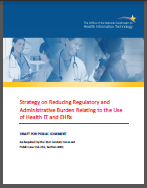A Public Health Perspective on ONC's Strategy to Reduce Burden on Physicians
 Noam H. Arzt, Ph.D.On November 28, 2018 ,the Office of the National Coordinator for Health Information Technology (ONC) released a draft Strategy on Reducing Regulatory and Administrative Burden Relating to the Use of Health IT and EHRs for public comment. The strategy aims to reduce the time and effort and improve the functionality of electronic health records (EHRs) for clinicians, hospitals, and other healthcare organizations.
Noam H. Arzt, Ph.D.On November 28, 2018 ,the Office of the National Coordinator for Health Information Technology (ONC) released a draft Strategy on Reducing Regulatory and Administrative Burden Relating to the Use of Health IT and EHRs for public comment. The strategy aims to reduce the time and effort and improve the functionality of electronic health records (EHRs) for clinicians, hospitals, and other healthcare organizations.
This strategy was developed primarily through the efforts of ONC-convened workgroups in response to requirements laid out by Congress in the 21st Century Cures Act (Section 13103). The report itself does not identify who exactly served on these workgroups and what organizations were represented.
The report is divided into four major sections each covering a different area: clinical documentation; health IT usability and the user experience; EHR reporting; and public health reporting. For each section ,the report briefly lays out the issues and challenges, and provides some key strategies and recommendations. There's some good stuff in here. I particularly liked a recommendation on clinical decision support (CDS) usability (p, 51), and another nice section on EHR Reporting (starting on p. 58). But since my interest is in public health, I'll provide some more detailed comments on that section.
 The report does a nice job of discussing and identifying the challenges and opportunities for data exchange between Federal agencies, and between clinical care and the Federal government. But this pretty much misses the boat. While the report recognizes that Federal agencies also fund data collection by state and local public health, they fail to recognize that state and local reporting represents the vast majority of the interoperability between public health and clinical care. Given the absence of public health law at the Federal level (it's almost all at the state/local level), it is public health reporting to the Federal government that is largely incidental.
The report does a nice job of discussing and identifying the challenges and opportunities for data exchange between Federal agencies, and between clinical care and the Federal government. But this pretty much misses the boat. While the report recognizes that Federal agencies also fund data collection by state and local public health, they fail to recognize that state and local reporting represents the vast majority of the interoperability between public health and clinical care. Given the absence of public health law at the Federal level (it's almost all at the state/local level), it is public health reporting to the Federal government that is largely incidental.
As a result of this misalignment, the recommendations fin this area are somewhat weak: inventorying of reporting requirements to identify common data, and a harmonization of reporting requirements across federally-funded programs. Public health already has a pretty good idea of what the reporting requirements are, and transport/data element standards are also largely known and understood. The primary obstacle to more commonality is the paltry funding that public health at all levels of government receives to implement what it already knows it has to do. The CDC's Surveillance Data Platform (SDP), Biosense Platform, and Digital Bridge project are just a few examples of leadership in this area.
The second area of focus for the public health section of the report is on substance abuse and PDMP-EHR integration. While this is an important area for the country today, there are far more fundamental and far-reaching domains which are equally important or even more important than substance abuse, like electronic case reporting (eCR) and syndromic surveillance with their ties to national biodefense preparedness, or the other core reporting measures that are part of the CMS Promoting Interoperability programs.
While it is useful for the workgroup to have focused on substance abuse issues, I find it more problematic that they focused exclusively on these issues. With so much material and thinking already developed on other areas of public health reporting I don't think the workgroup would have had too much trouble addressing a broader set of issues with proper guidance.
Comments and suggestions on this strategy document are due to ONC by January 29, 2019.
- Tags:
- 21st Century Cures Act
- Biosense Platform
- CDS usability
- Centers for Disease Control and Prevention (CDC)
- Clinical Decision Support (CDS)
- clinical documentation
- Digital Bridge project
- EHR administrative burden
- EHR Functionality
- EHR regulatory burden
- EHR reporting
- EHR usability
- EHR user experience
- electronic case reporting (eCR)
- electronic health records (EHRs)
- Health IT
- health IT usability
- medical errors
- national biodefense preparedness
- Noam H. Arzt
- Office of the National Coordinator for Health Information Technology (ONC)
- physician burnout
- physician suicide
- public health reporting
- substance abuse and PDMP-EHR integration
- Surveillance Data Platform (SDP)
- Login to post comments